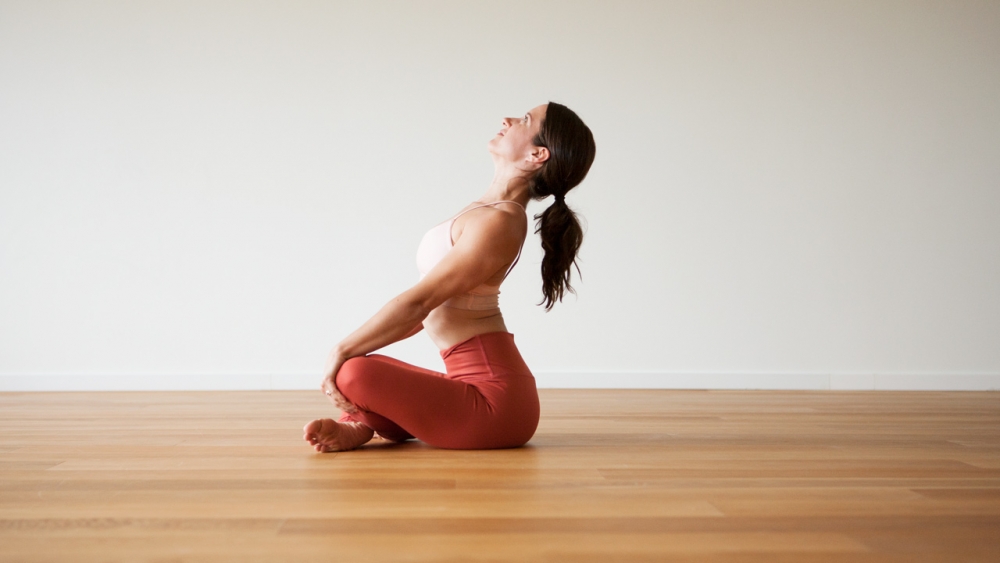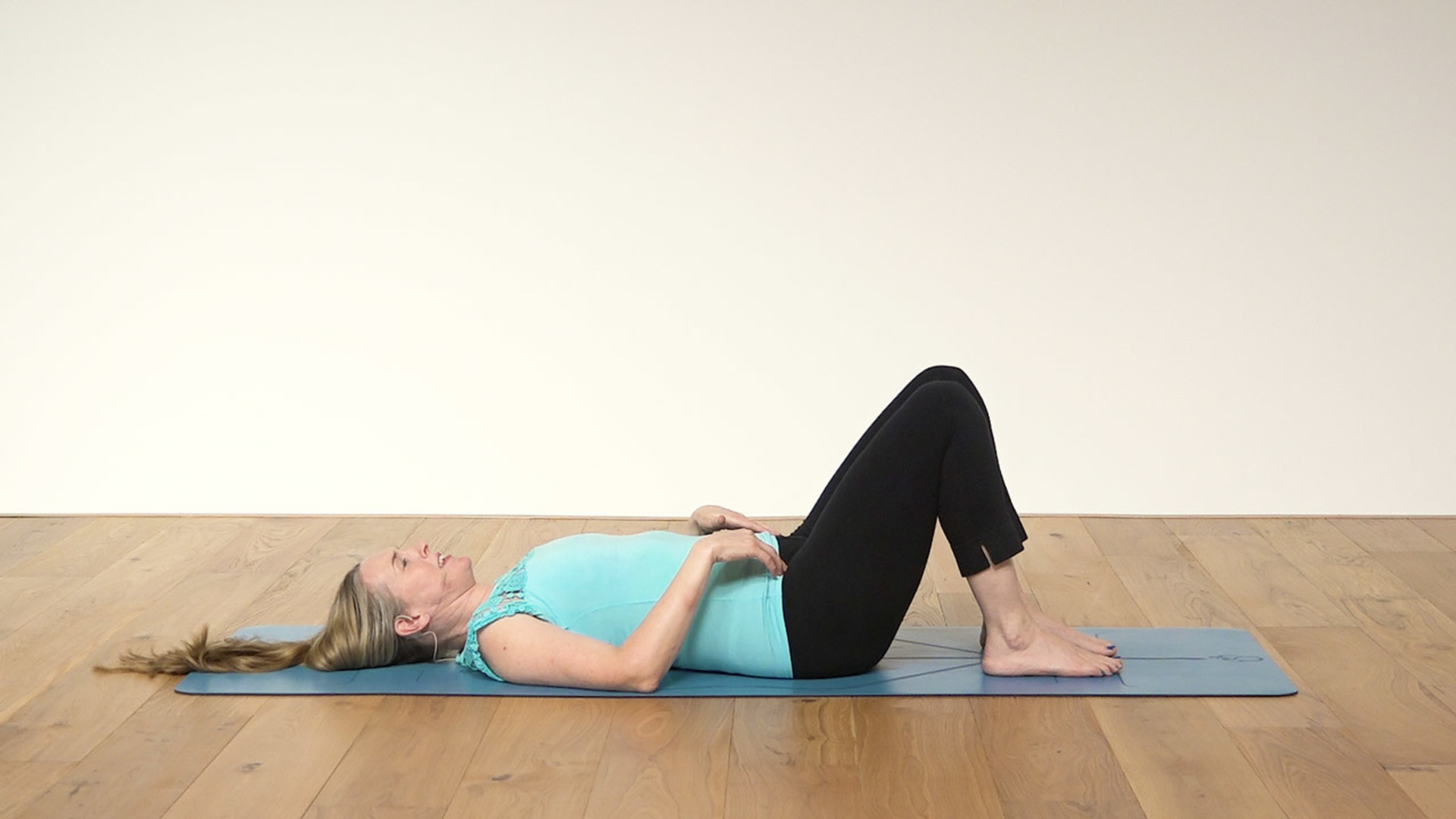No matter our level of experience with yoga, we can all experience a greater connection to ourselves when we understand our physical bodies better and how everything fits together. This exploration will give you a greater awareness of your anatomy and the relative movement that you have – because it’s not about comparing to someone else, or to some notion of a ‘perfect’ person; it’s an individual journey.
The lower back
The lower back is an area of our body which demands much attention in yoga, particularly if it isn’t too happy, or doesn’t allow as much freedom as we’d like. It’s also an area associated with pain, particularly in our Western bodies.
If you haven’t got the amount of mobility that you’d like in your pelvis and lumbar area, there’s a great pelvic rocking exercise further down which may help. If you’ve got pain in your lower back, in a nutshell, it’s because the system isn’t moving as it could… Now, you might say that it’s not moving because it hurts! But I’m suggesting that it hurts because it’s not moving, so that exercise below might be helpful there too.
Getting your back moving is key, but it’s helpful to have an understanding of our anatomy so that we can better understand how to move. I’m starting at the pelvis, because this is the basis from which the lower back arises and from where our spine’s mobility starts.
Getting familiar with your pelvis
If you place your hands on your hips, with your forefingers at the front and your thumbs to the rear, then your forefinger will land on a bony bit and you’ll be able to roll your fingers out and at an angle to the sides. Your thumbs at the back will find a ridge over which they roll up and down. This ridge under your thumbs is slightly higher than the level of the bony bit under your forefingers.
These two points form a continuum that is the rim of your pelvis; the ‘ilium’. The pelvis is comprised of the ilium bone (the ‘wings’ of the pelvis, as it were), the pubic bone to the lower front, and the ischium to the rear at the base. These three bones are fused together but are actually separate bones in childhood.
There’s a lot of muscular attachment to the rim of your pelvis – not least your gluteals, and some of your back muscles. If you’re sitting down, keep your hands on your hips and rock backwards and forwards and feel the relative position of your fingers and thumbs. You’ll also notice that your back moves – generally speaking, it ‘arches’ as you tip your pelvis forwards (and forefingers drop lower still), and your back rounds when your thumbs lower and fingers rise up. You might find that your entire back moves…and your chest and your head! Of course, they’re all connected (but we’ll get to the other parts of the back later in this series of articles).
You can feel the effect of tipping your pelvis if you’re standing, but it’s more evident if you’re sitting down because you have a reference point against the seat. You’ll feel that you’re rocking forwards and backwards over the bony points in your buttocks – these are your ‘ischial tuberosities’ – otherwise known as the sitting bones! This ‘pelvic rocking’ is really beneficial to do little and often as an exercise by itself. Especially if (like many people) you find it tough to sit up tall when sitting on the floor, or to reach your toes in a forward bend.
You might associate not being able to touch your toes with tight hamstrings, but the backs of your legs are intrinsically connected to your pelvis and your lower back…so it might not be that your hamstrings are tight after all – it might be a lack of mobility in your back instead!
Playing around with this ‘pelvis rocking’ exercise might start to help free up your pelvic and lumbar mobility, but know that this exercise can be a slow-burner to see the effects of it. The circumstances which led to the limitation took time to develop and they’ll take time to reverse as well.
Practise in class with Lisa Petersen
Pelvic Shenanigans – 15 mins – a class which brings a simple and easy freedom to the pelvis and lower back.
The sacrum and ASIS
Now we’ve found our way around the pelvis, let’s return to your back. If you can happily take one of your hands fully behind your back, place it so that the palm is flat, fingers towards the floor and so that the tip of your middle finger reaches the top of what we might call your “buttock cleavage”.
Your palm is now lying on your sacrum (the fused 5 vertebrae below your lower back, or ‘lumbar’ spine). That tip of your middle finger should coincide with a little indent, which is the start of your tailbone (or coccyx, and the lowest 4 vertebrae, which are also fused). Now if you start to rock forwards and backwards again with your palm still in situ, you may notice that the wings of your pelvis squeeze together just a little bit and the sacrum slides inside the two sides as well.
The sacrum nestles inside the wings of your ilium, and it’s not uncommon to have some slightly tender points around the junction of these two – where the muscles are tighter and ‘holding on’, albeit inadvertently. Where there’s tightness in our tissues, limited mobility in the joint can occur as a result of some other group of muscles not working as they could. Freeing the tissues which are tight and then strengthening those which are not firing as they could, will help bring back balance to the area.
Strengthening will also be required if there’s an excess of mobility in a joint. In this case, strengthening the stabilising muscles around the joint by focusing on slower, smaller, controlled movements. Here, Hatha yoga may be better suited for your body to register the fine muscle work thana fast-flowing practice like Ashtanga, for instance.
We’re always striking a balance between the mobility in a joint, and the stability within the surrounding tissues. Here’s a great sequence of Esther Ekhart’s to help stabilise our hips and have a healthy back as a result – Strong glutes, stable hips and a pain-free back.
Now we’re getting to your lower back!
Switch your hands back on your hips and replace your fingertips on those bony protrusions at the front again (these are called your ‘anterior superior iliac spine’ – or ASIS for short. Anatomical labelling loves its abbreviations). This time, stretch your thumbs (at the same height as your forefingers) all the way around to your spine at the back, until your thumbs touch. You’ve now located your 4th lumbar vertebra (out of 5) – congratulations!
The 4th lumbar vertebra (let’s call it L4, for sake of ease) and L5 are pretty well attached to the sacrum, although they’re distinct bones, and they both sit within the broad sweeps of the pelvis. There’s not a great deal of mobility with these two lower vertebrae. The action really begins at L3.
L3 – finding uplift and space
L3 is a nice little vertebra because it’s the start of something new, with new possibilities. The lumbar spine is characterised as a convex ‘c’ shape. Being the middle vertebra of the five, this third lumbar vertebra is horizontal to the ground as it facilitates the ‘change in direction’ within the curve.
The lower two vertebrae are strongly connected to the sacrum and their role is more of a downwards support mechanism connecting towards the ground. L3, however, is a junction from where we can lift upwards; from where our spine can find lightness and space. It’s the area where the mobility and the first modicum of rotation occurs in the lumbar spine.
L4 and L5 can often get ‘stuck’ (even within the context that they have limited mobility) so smooth, mobile ‘rolling’ when we curl our tailbone underneath us can feel more like a solid block. But L3 is like a breath of fresh air! It’s from here we can extend when we’re in Extended child’s pose. With our pelvis and those lower two vertebrae pouring away behind us, L3 gives us space from which to lengthen…
Perfectly imperfect
Now that you’ve become nicely acquainted with your lumbar spine, know that what you feel is ‘normal’ for you. We all have relative proportions which work for our dimensions but there is no model of “anatomical perfection”. Well, there is – as long as you’re pain-free, it’s you! It’s all of us – we’re just all perfectly slight variations of a model.
If you experience pain in your back, unless you’ve experienced a trauma like a car accident, it doesn’t necessarily help to look inside at the structure of the spine. Because the structure (the bones and discs that sit in between the vertebrae) is generally not to blame for your pain. The spine is made up of lumpy bits, gnarly bits, possibly even protruding bits…it is a living, moving, responding, ever-changing thing. The spine’s appearance changes all the time, just like the appearance of your feet, which is why the snapshot of a scan or x-ray is not necessarily useful and does not strictly show why we’re in pain.
When the tissue (muscles and fascia) in your back is tight because it’s holding a lot of tension (read: held energy), it will pull the rest of our structure out of balance and off-centre. Therefore, rather than seeing an x-ray or a scan of your back, it can be much more powerful to get friendly with your anatomy through your mind’s eye and through the touch of your own hands (or a physiotherapist’s). That way you’re much better informed to sense if something’s tight, tender or out of whack…
We’ve orientated our way around the bony structures, we’ve touched briefly on the musculature, and next time we’ll wrap our heads around fascia before journeying up to the thoracic spine.
More from Dawn’s anatomy series
- Anatomy of the spine – connected by the waist
- Anatomy of the spine – the upper back
- Anatomy of the spine – the neck
About the author:
Dawn Meredith-Davies MSc is a holistic physiotherapist, yoga teacher and writer. Having practised yoga for over 15 years, Dawn incorporates this in her clinic work together with hands-on treatment, acupuncture, nutrition and the all-important breath.
When she’s not on the mat, getting outdoors and running is Dawn’s mainstay. As a specialist in movement analysis for running, Dawn brings together all of these tools, as well her professional practice, her love of writing and sharing the good stuff at her Living Green Health website to help you run, breathe and live green!


